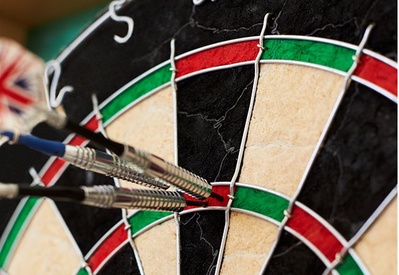 In some sports and games, there are certain widely established measures you can use to get an accurate picture of someone’s ability. In golf, this takes the form of a handicap while in chess, players have an ELO ranking.
In some sports and games, there are certain widely established measures you can use to get an accurate picture of someone’s ability. In golf, this takes the form of a handicap while in chess, players have an ELO ranking.
With darts, however, there are three different averages you can choose from: MPR, PPD and PPR.
These averages can be used by professionals and amateurs alike so feel free to compare your scores with your mates at the pub or to the top professionals.
Getting an accurate reflection of your ability does require keeping track of a lot of games though so a little bit of effort is required on your behalf. In this article, we’ll explain how each of the averages is calculated and which is ultimately the most useful.
MPR: Marks Per Round
 MPR (marks per round) is an average you would most often use if playing the game of cricket. Before you get confused, we do not mean the wooden stumps and big white pads game. Somewhat confusingly, cricket is also the name of a darts game although it goes by several other names such as Tactics, Horse and Carriage, Coach and Horses, and Faldo. In addition to cricket, you may also keep track of MPR for games such as 501 or 301 but this is less common.
MPR (marks per round) is an average you would most often use if playing the game of cricket. Before you get confused, we do not mean the wooden stumps and big white pads game. Somewhat confusingly, cricket is also the name of a darts game although it goes by several other names such as Tactics, Horse and Carriage, Coach and Horses, and Faldo. In addition to cricket, you may also keep track of MPR for games such as 501 or 301 but this is less common.
There are no big numbers involved with MPR scoring as it ranges from zero to nine, with nine being the top possible mark. On each throw of a dart, a treble is worth three points, a double two and a single one. If you hit trebles every single time without missing (hats off to you), you would have an MPR of 9. The formula to apply is: (the total of all marks) divided by (the number of darts thrown) multiplied by three. If you threw two trebles, two double and two single the calculation would be (3+3+2+2+1+1 / 6) * 3 = 6.
Providing you are able to hit the board with all your darts then you will have an MPR of at least 1. Many casual players do not exceed this by much though with a typical rating for someone who plays occasionally at the pub being 1 to 2. Those at competitive levels will usually have an MPR of at least 3.5.
PPD: Points Per Dart
 PPD stands for points per dart and for this the range is much broader. The maximum PPD is 60 and you would achieve this by hitting treble 20. Any PPD will always be less than this though given that smaller numbers are required to finish a game. If it takes you 15 darts to go from 501 to out, then your PPD for that leg will be 33.4. In other words, the average value for each dart you threw was 33.4. The higher your average, the more valuable each of your throws is and this is almost always a good thing. Someone that can regularly hit triple 20 should enjoy a good PPD on an account of all the 60s they are racking up.
PPD stands for points per dart and for this the range is much broader. The maximum PPD is 60 and you would achieve this by hitting treble 20. Any PPD will always be less than this though given that smaller numbers are required to finish a game. If it takes you 15 darts to go from 501 to out, then your PPD for that leg will be 33.4. In other words, the average value for each dart you threw was 33.4. The higher your average, the more valuable each of your throws is and this is almost always a good thing. Someone that can regularly hit triple 20 should enjoy a good PPD on an account of all the 60s they are racking up.
The British Darts Organisation (BDO) operated two separate PPD calculations depending on if a player won or lost the leg. The victor simply applies the standard 501 divided by total darts thrown. The loser’s calculation however will be (501 – the score they have left) / the total number of darts thrown. So, if you still had 105 left to go when the leg finished having thrown 15 darts, you would work out (501 – 105) / 15 = 26.4. We put the BDO in the past tense because the organisation was liquated in 2020, leaving the Professional Darts Corporation (PDC) as the undisputed British darts body. Unlike the BDO, the PDC never really bothered with one-dart calculations, preferring to focus on the three dart average.
PPR: Points Per Round
 This brings us very nicely onto the last average we will discuss, PPR. It stands for points per round and is also known as the three dart average. Calculating PPR is a straightforward task – the same as how you would work out the PPD, only with a multiplication at the end. For any player that has won the leg, the formula is simply (501 / total darts thrown) * 3. As for the loser, this needs tweaking to ((501 – score remaining) / total darts thrown) * 3. If in one game it takes a player 15 darts to finish, this will give them a PPR average of 100.2
This brings us very nicely onto the last average we will discuss, PPR. It stands for points per round and is also known as the three dart average. Calculating PPR is a straightforward task – the same as how you would work out the PPD, only with a multiplication at the end. For any player that has won the leg, the formula is simply (501 / total darts thrown) * 3. As for the loser, this needs tweaking to ((501 – score remaining) / total darts thrown) * 3. If in one game it takes a player 15 darts to finish, this will give them a PPR average of 100.2
You would do very well to find any player on the planet who could boast a long-term average 100.2 as in the example above. At the time of writing, only two players had a PPR exceeding 100, Michael van Gerwen with 100.39 and Peter Wright with 100.08. The remaining leading pros found themselves in the 90 to 100 range. To be good enough to play at a competitive local level, you ought to have a PPR within the 60 to 80 range. Any lower than this and you will likely need more practice.
Always bear in mind these are long-term averages but players may end up throwing much higher or lower than this in any given game. There have been numerous instances of players having PPR averages of more than 115 in a televised match with the best being Van Gerwen’s 123.40 which he managed in a 7-1 win over Michael Smith in 2016. Peter Wright did go even better with a PPR of 123.50 three years later but this was not televised, only streamed.
A Word About Averages
Like when dealing with any calculation involving averages, the larger the sample size the more reliable the data. In football, if a striker had scored six goals in two games (an average of three goals a game) this looks great but is unlikely to be an accurate representation of their ability to score goals over the course of the season. The more games a darts player has had, the more reliable their averages will be and this allows for more meaningful comparisons to be made.
As for which average is ‘best’, it partly depends where you are. MPR gets little mention in the UK but it is bigger within the USA for example. The one dart average (PPD) has its value but, especially with the fall of the BDO, PPR is now by far the most commonly used metric. This is the only average the PDC really covers and for this reason, it is the one we would consider to be the most valuable.
